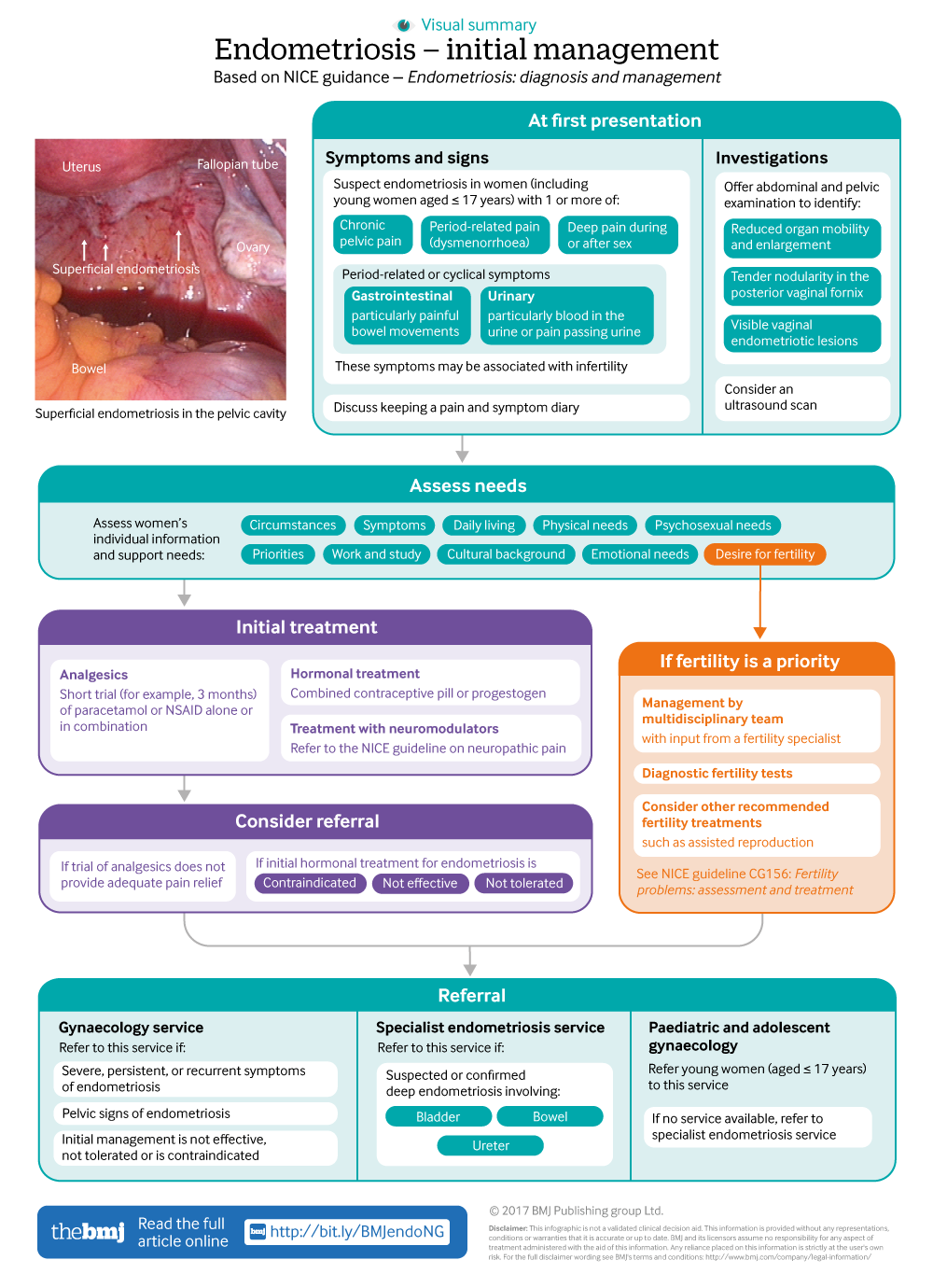Diagnosis and management of endometriosis: summary of NICE guidance
BMJ 2017; 358 doi: https://doi.org/10.1136/bmj.j3935 (Published 06 September 2017) Cite this as: BMJ 2017;358:j3935
Infographic available
Click here for a visual summary of newly updated NICE guidance for endometriosis diagnosis and management.
- Laura Kuznetsov, systematic reviewer1,
- Katharina Dworzynski, guideline lead1,
- Melanie Davies, clinical advisor and consultant gynaecologist1 2,
- Caroline Overton, chair of Guideline Committee and consultant gynaecologist, subspecialist in reproductive medicine and laparoscopic surgery3
- on behalf of the Guideline Committee
- 1National Guideline Alliance, Royal College of Obstetricians and Gynaecologists, London NW1 4RG, UK
- 2University College London Hospitals, London, UK
- 3St Michael’s University Hospital, Bristol, UK
- Correspondence to: M Davies mdavies{at}rcog.org.uk
What you need to know
Endometriosis can be difficult to diagnose, with some studies showing a delay in diagnosis of 4-10 years, resulting in decreased quality of life and disease progression
Endometriosis cannot be ruled out by a normal examination and pelvic ultrasound
Hormonal treatments for endometriosis suppress menstruation and reduce pain. They are contraceptive but have no effect on subsequent fertility after discontinuation
Refer women to a gynaecology service if they have severe, persistent, or recurrent symptoms of endometriosis, if they have pelvic signs of endometriosis, or if initial management is not effective, not tolerated, or is contraindicated
Endometriosis can be a long term condition, with substantial physical, sexual, psychological, and social impact
Endometriosis is one of the most common gynaecological disorders, affecting an estimated 10% of women in the reproductive age group (usually 15-49 years old), and in the UK it is the second most common gynaecological condition (after fibroids).1 Endometriosis is hormone mediated and is associated with menstruation. The precise cause is not known, but it is widely accepted that endometrial cells deposited in the pelvis by retrograde menstruation are capable of implantation and development. It is a long term condition causing pelvic pain, painful periods, and subfertility. Endometriosis presents a diagnostic and clinical challenge, with many women left undiagnosed, often for many years. Small observational studies have reported delays of 4-10 years in diagnosis,23 which can result in decreased quality of life4 and disease progression.5 The diagnostic delay is not limited to adults; endometriosis is also often missed in adolescent girls,6 and this guideline aims to improve care by highlighting this age group in some recommendations.
This article summarises the most recent recommendations from the National Institute for Health and Care Excellence (NICE) on diagnosis and management of endometriosis.7 The recommendations were based on …
Log in
Log in using your username and password
Log in through your institution
Subscribe from £173 *
Subscribe and get access to all BMJ articles, and much more.
* For online subscription
Access this article for 1 day for:
£38 / $45 / €42 (excludes VAT)
You can download a PDF version for your personal record.
